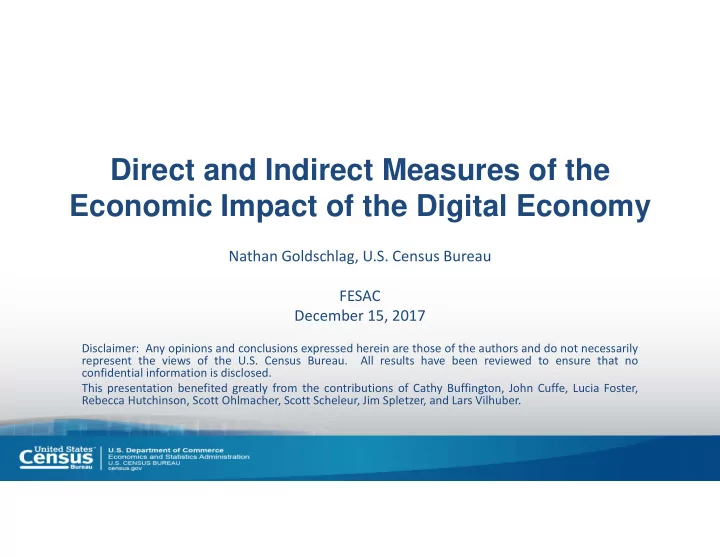

Direct and Indirect Measures of the Economic Impact of the Digital Economy Nathan Goldschlag, U.S. Census Bureau FESAC December 15, 2017 Disclaimer: Any opinions and conclusions expressed herein are those of the authors and do not necessarily represent the views of the U.S. Census Bureau. All results have been reviewed to ensure that no confidential information is disclosed. This presentation benefited greatly from the contributions of Cathy Buffington, John Cuffe, Lucia Foster, Rebecca Hutchinson, Scott Ohlmacher, Scott Scheleur, Jim Spletzer, and Lars Vilhuber.
Goal of Presentation Questions: How can we use survey data to target specific questions of interest? How can we leverage existing data to identify sectors affected by the digital economy? How do we develop forward looking uses of big data to measure the digital economy? Today: Many ‐ course tasting Brief overview of active and potential projects 2
Measurement Agenda Traditional Direct Survey Data E ‐ Commerce ABS, MOPS, ASM Administrative Data BDS, QWI High Tech Gig Economy Occupation Dynamics Big Data Firm Technology Profiles Technology Shipments Non ‐ Traditional Indirect 3
E-commerce Statistics Annual E ‐ Stats publication, since 1999, multi ‐ sector report ASM, AWTS, ARTS, SAS Quarterly Retail E ‐ Commerce stats $32 bn (3%) in 2007Q1 to $106 bn (8.5%) in 2017Q1 Percent Change in Quarterly Retail E ‐ commerce Sales from Prior Year 1st Quarter 2007 ‐ 1st Quarter 2017 (Data adjusted for seasonal variation and holiday and trading ‐ day differences) 45 35 25 20.122.320.7 18.8 15.1 17.116.418.319.417.9 17.617.015.116.3 15.414.2 14.7 15.3 13.014.113.112.813.714.915.3 14.114.414.7 15.5 14.9 13.5 14.0 14.013.5 14.1 15 9.0 4.2 5 3.1 -5 -7.7 -5.2 -3.4 -15 4
2017 ABS Technology Annual Business Survey (ABS) samples ~850,000 firms across all sectors excluding agriculture Questions added to measure intensity (slight, moderate, intensive) of use of technologies Augmented reality Digitization of business data Cloud services Machine learning Automation technologies RFID inventory systems 5
Management and Organizational Practices Survey of more than 30,000 establishments in manufacturing (ASM mail sample), 2010 and 2015 Topics include management practices, organization, data and decision making, and uncertainty MOPS 2015 and the use of data: 1. Availability of data 2. Use of data 3. Who chooses data 4. Sources of data 5. Activities using data 6. Reliance on predictive analytics 6
2018 ASM Industrial Robotics Industrial robot is an automatically controlled, reprogrammable, and multipurpose machine used in industrial automation Mobile, stand ‐ alone stations, or integrated into production Used in welding, material handling, machine tending, dispensing, and pick and place 2018 ASM questions on industrial robots Gross value of robotic equipment Capital expenditures on robotic equip. 7
Measurement Agenda Survey Data E ‐ Commerce ABS, MOPS, ASM Administrative Data BDS, QWI High Tech Gig Economy Occupation Dynamics Big Data Firm Technology Profiles Technology Shipments 8
Business Dynamics of High Tech Industries High Tech industries using/producing good/services impacting digital economy Goldschlag & Miranda (2016) update Hecker (2005) OES STEM employment concentration Includes gas extraction, manufacturing, information, and professional services Use that classification to generate statistics from LBD/BDS administrative data 9
High Tech Employment Dynamics LEHD infrastructure provides Demographics and dynamics in HT [QWI] Fine geographic details [QWI] Sources of employment flows (geography, industries) [J2J] Alternate classification of High Tech industries Direct measures (ACS link to LEHD) to identify industries 10
Measuring the Gig Economy Gig workers are, by 24,000,000 definition, self ‐ employed The measurement of self ‐ 18,000,000 employment differs across household surveys (CPS, ACS) 12,000,000 and administrative tax data Questions: Who are these workers? 6,000,000 1996 1997 1998 1999 2000 2001 2002 2003 2004 2005 2006 2007 2008 2009 2010 2011 2012 Are these 2 nd jobs? Are we measuring these jobs Nonemployers Nonemployer Sole Proprietors DER Self Employed 1099 ‐ MISC, Indiv + Business in our surveys? 1099 ‐ MISC, Individuals CPS Monthly, Main Job Last Week CPS ASEC, All Jobs Last Year CPS ASEC, Longest Job Last Year ACS, Main Job Last Week 11
Occupational Dynamics Better measures of trends and dynamics of occupational employment (e.g. longitudinal OES) Technology replacing routine manual jobs Examples: self ‐ checkout machines, travel agents Promising avenues: Occupational text fields from 1040 tax forms? Bakija, Cole, & Heim (2012) Big data sources such as web ‐ scraped job postings data 12
Measurement Agenda Survey Data E ‐ Commerce ABS, MOPS, ASM Administrative Data BDS, QWI High Tech Gig Economy Occupation Dynamics Big Data Firm Technology Profiles Technology Shipments 13
Firm Technology Profiles from Big Data Existing project using machine learning techniques to enhance industry classification Easing respondent burden Use public data (Google Places API) to generate industry classifications Retooling to measure digital economy Use data from company websites, Google Places API Firm technology profiles (e.g. data, analytics, robotics, artificial intelligence) 14
Producer Data – Robotics The Robotic Industries Association (RIA) collects data from producers of robotics Measures of shipments to industries and geographies Partnerships with trade associations such as RIA could enhance/replace survey collections on robotics Trade associations and producers may benefit from statistical products using association data, reduce burden 15
Discussion and Questions How do we overcome barriers to leveraging existing administrative data? (1040s, pre ‐ 2005 W2s) How do we foster relationships with private data generating institutions? (RIA) How do we better leverage various types of “digital exhaust” to provide more timely estimates? State business registries (Guzman and Stern 2016) Google searches (Wu and Brynjolfsson 2015, Goel et al 2010) Yelp data (Glaeser, Kim, and Luca 2017) Cell phone data (Calabrese, Lorenzo, Ratti 2011) Other sources? Cloud computing? How do we standardize the way we ingest and integrate non ‐ traditional data? How do non ‐ traditional data impact disclosure? 16
Recommend
More recommend